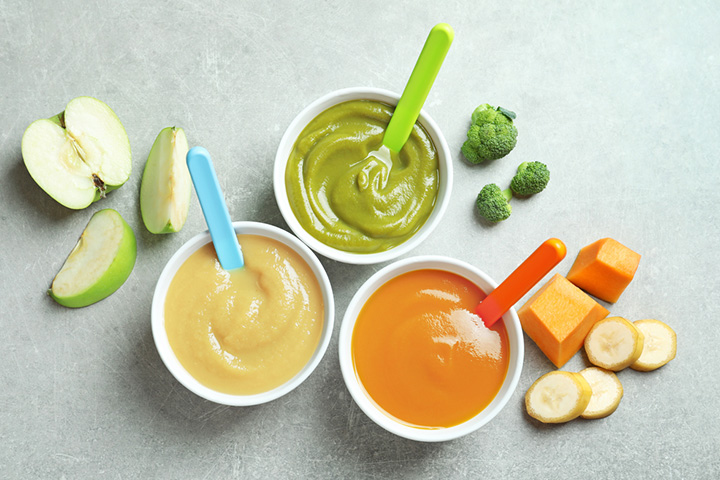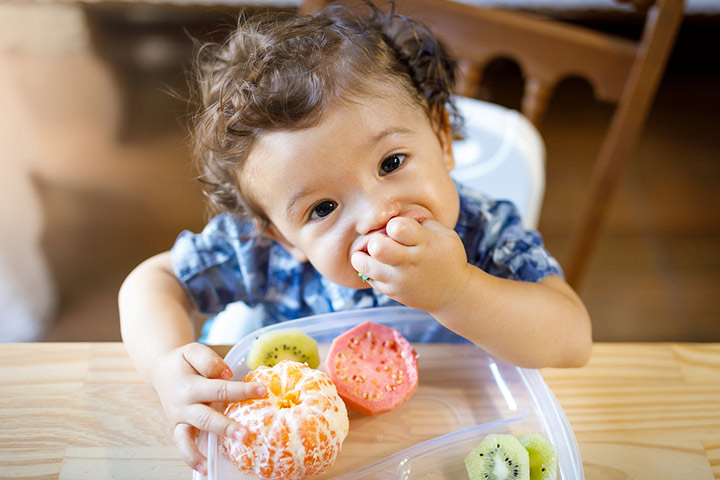
Image: Shutterstock
How much and how frequently you should feed your child is a crucial decision every parent must make. If you are transitioning to solids with your child, it can be confusing to select the right stage of baby food that they require. You must have noticed pouches, jars, and packages at the grocery store having numbers labeled on them. What do they mean, and which one should you pick for your baby?
During the initial months of feeding solids, the stage approach can be helpful. The stage approach makes progress into a diet of varied textures and flavors easier. Wondering how to make the best use of it? Read on to know more about the introduction of solids stage-wise:
Image: Shutterstock
Baby food stages refer to homemade purees and store-bought food. Your baby can be introduced to solids around the time they are six months old. If you begin earlier than that, your baby could choke on solids. Also, know that starting solid food too late can delay eating skills (1).
TheAmerican Academy of Pediatrics has advised that your baby should be comfortable with the process of eating. They should eat from a spoon, sit up, rest between each bite, and signal when full. These will help your baby learn good eating habits and table manners in the long run (2).
1. Baby Food Stage 1
Image: IStock
This is perfect for babies aged six months. The consistency of the purees is thin. It contains no chunks or pieces and is often made of a single ingredient only. You can begin with any food of your choice instead of sticking to rice cereal. Your options can range from fruit or vegetable purees to pureed meat. Stick to small spoonfuls. Purees can be mixed with breastmilk or formula. Remember that it’s okay if your baby spits the food out since they have just begun to learn how to swallow whole foods (3).
2. Baby Food Stage 2
Image: IStock
This stage is suitable for babies experienced with solids, around seven to eight months of age. The consistency of the solids is slightly thicker. It can contain multiple ingredients with complex flavors. Your baby may take time to get used to the new textures. This is because it’s a new experience, and some time may be required to adapt. Be patient and stick to small spoonfuls. If your baby doesn’t eat thicker textures, it could hint at underlying medical conditions or delays. Your pediatrician might need to intervene to find out the cause (4).
You must introduce quite a few flavors at this stage. This will build familiarity with varied tastes and textures. It could also help you deal with the picky eating phase that can be a thing during your baby’s toddler years. Stick to blends of foods like carrots, green beans, or squashes so they can accept other vegetables later on than babies who feed on single vegetables.
3. Baby Food Stage 3
Image: IStock
This stage is best suited for babies between the ages of nine and twelve months. Thicker textures are suitable. You can also include chunks and pieces that your baby can easily chew. Finger foods can also be given at this stage. Your baby may not like lumpy food on their spoons but stay patient. You can introduce finger foods like avocado, tofu, well-cooked carrots with cheese or broccoli, O-shaped cereal. Grocery counters could be filled with baby “snacks” or finger foods loaded with sugar. Avoid them and stick to home-cooked foods instead (5).
4. Baby Food Stage 4
Image: IStock
This stage is usually around the age of twelve months and older. You can feed your baby what the family is eating or stick to commercial toddler foods. Make sure the food is well-balanced to get the right kind of nutrition for growth and development (6).
Keep in mind that these are general guidelines to help you figure out what to feed your child at each stage of their growth. Some babies are ready for stage 2 foods even before they turn eight months old, while others may take longer. So, instead of sticking to these guidelines, strictly let your baby advance through each stage in their own time.
You can consult your pediatrician to help guide you on whether your baby will need more time to adapt and progress to the next stage. Also, while the time to start solids can vary for each baby, one thing to bear in mind is that they should be able to sit up and have head and neck control first. If your baby remains stuck at one stage only and can’t move to the next naturally, speak to your pediatrician (7).
With different brands labeling their foods differently, it may not be very clear for parents to introduce options to their children. These guidelines can help you figure out a suitable plan for introducing solids. Did you face any difficulty while introducing solids to your baby? Do share your experiences with us in the comments section below.

















